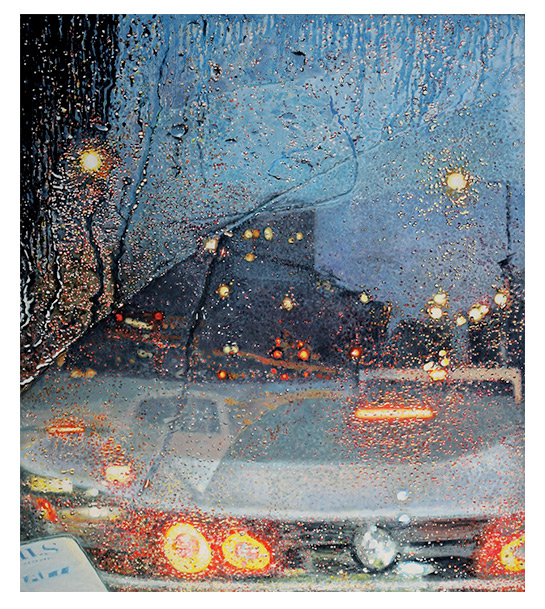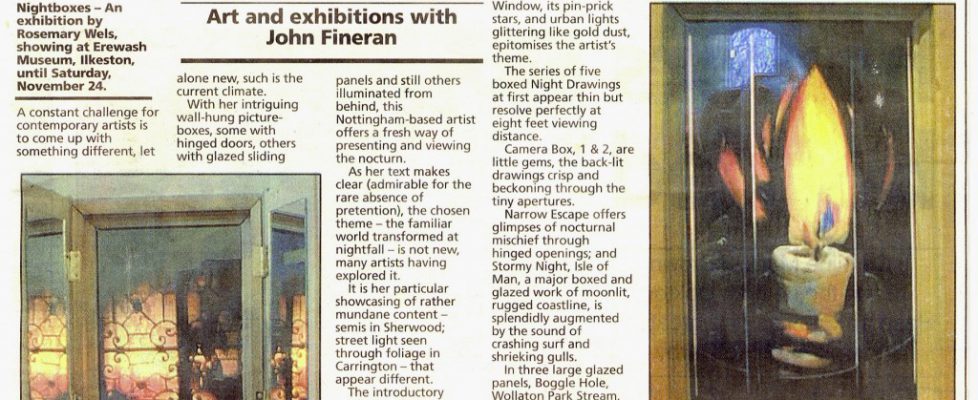‘SEEING THROUGH’ Solo show at the Wallner Gallery, University of Nottingham.

“Is this the real life? Is this just fantasy? …Caught in a landslide, no escape from reality” as the lyric goes in Bohemian Rhapsody.
These words from the well-known Queen lyric have a bearing on the new paintings by Rosemary Wels. Are they fantasy or reality? Certainly they create something extraordinary from our known world as they conceal and reveal simultaneously, images frozen in time. Transitory weather conditions and their effect, seen through glass, are the themes explored in these paintings.
An artist inevitably works at a distance from a chosen subject, since the activity of painting is at one or more removes from its origin or inspiration. She may be surrounded by drawings and photographs made preparatory to working on canvas, but as the painting evolves it will make its own demands, directed by the shapes, images and dimensions of the picture plane.
The visual experience from which each work originated was observed and recorded as sketch or photograph. Time passed then the memory and the visual record kicked in, for this artist feels a continued excitement when representing the visual world in new ways. As a practising artist in painting and printmaking, she taught the subject for many years. The technical skills involved in both fields have become second nature to her, providing a basis for her work in general, whether on screens or with oil paint on canvas. Her awareness of the actuality of things and the challenge to depict complexities of light and darkness has engrossed her for years in several series of paintings. ‘Drawing the Moon, Images of Night’ allowed her to examine the effects of moonlight and street lights in the city at night, nature versus the artificial. Working on black surfaces with white media she explored ‘drawing in reverse’ ie light on dark, continuing the theme with her inventive ‘Night Boxes.’
In 2017, a collaboration with university astronomer Meghan Gray led her to investigate the night sky from a different perspective, that of looking at structures in space. ‘Abell Galaxy Cluster 2218 ’ was the intriguing result. This multi-media 3D installation with moving lights was shown at ‘The Pint of Science’ event at Nottingham Contemporary that year.
In this exhibition we find a combination of natural elements (rain drops) with the artificial neon and street lights glinting in city streets. Mainly using photography to record a visual incident, where a concurrence of lights on surfaces near to are seen behind the window of a car or train, she then makes sketches and notes to back up the image. Some daytime images have an added immediacy of movement too, where the swishing bubbles in a car wash are almost threatening! It is significant that she is an admirer of the great Japanese printmaker Hokusai, whose masterpiece, ‘The Great Wave’ has bubbles of spray in the foreground of his distant view of Mount Fuji. Hokusai was the supreme master of ‘ukiyo-e’ the ‘floating world’ school of Japanese wood block printers.
Timothy Clark, Head of the Japanese collections at the British Museum, writes about the aspect of immediacy in ‘The Great Wave’ and its sense of menace in a frozen moment in time. Here in these paintings of a similarly immediate occurrence, it is the knowledge of screen printing rather than wood block that allows Wels to use layers that first conceal then reveal a more distant image. Her raindrops could be the real subject rather than the blurred images behind them. Real life or fantasy? Our eyes can focus on details of a misty window pane but then must refocus to see what lies behind.
Pauline Lucas 2019

